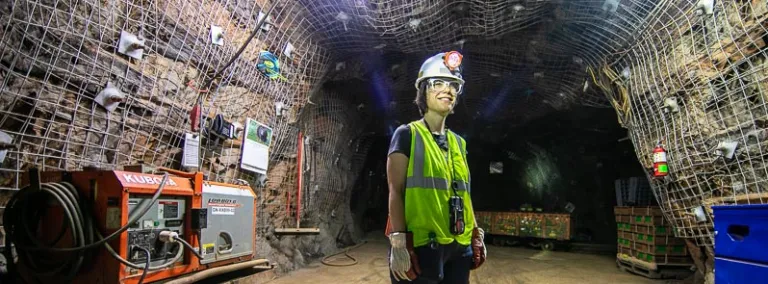Sanford Lab welcomes first-ever Artist-in-Residence
Artist will create a body of work based on the research and atmosphere of Sanford Lab
On her most recent trip to the 4850 Level of Sanford Underground Research Facility (Sanford Lab), Gina Gibson snapped photos of LUX-ZEPLIN’s gleaming titanium cryostat, recorded a sound bite of a jackleg drill echoing through the drift and took copious notes in a field journal. Her research is not focused on dark matter or underground engineering; rather, Gibson is on the hunt for inspiration.
Gibson, a professor of digital communication at Black Hills State University (BHSU), is Sanford Lab’s first-ever artist-in-residence, and the photos, audio and notes she gathers during her visits to Sanford Lab are all part of the creative process.
The Sanford Lab Artist-in-Residence (AiR) program is a one-year program that gives artists an opportunity to explore the unique environment at Sanford Lab and create artistic works. During this residency, an artist will explore a variety of areas—both underground and on the surface. These experiences will inspire a body of work based on the research and other activities taking place at Sanford Lab and will culminate in a public exhibition during Sanford Lab’s annual Neutrino Day event and a Deep Talks lecture.
"Throughout Sanford Lab's history, we’ve leveraged the arts to help tell the story of the science at Sanford Lab and the experience of working nearly a mile underground," said Mike Headley, executive director of Sanford Lab. "We’re expanding our outreach efforts through the new Artist-in-Residence program to work directly with a regional artist to develop a collection inspired by our facility."
Gibson, who was granted full professorship at BHSU in 2019, is a multimedia artist. As such, she combines sculpture, drawing, printmaking, digital design and other media to create unique bodies of work.
“I remember, in my undergraduate work, taking a photo of a sculpture I'd created and manipulating it digitally on the computer. I then printed it out and drew on top of that,” Gibson explained. “I put it all together, and it just seemed natural.”
Gibson first visited Sanford Lab in 2013 for the “Into the Dark: Artists Exploring Dark Matter" art exhibit, which challenged 22 prominent South Dakota artists to imagine one of nature's most profound mysteries: dark matter. After that experience, Gibson began searching for residency opportunities at labs like Fermilab and CERN, before realizing an opportunity might exist right here in the Black Hills. She worked with Sanford Lab to develop and pilot the AiR program.
While she doesn’t know what types of pieces will materialize, her time spent in laboratory spaces and earthy drifts alike is already inspiring her creativity.
“The lights, sounds, textures of this space—all of it together grabs my attention,” said Gibson. “It's so different from what is above ground. When you juxtapose the clean spaces with the rawer aspects—the rock and metal ground support—there’s so much visual texture.”
The atmosphere of Sanford Lab will play a large role in informing Gibson’s art, but she’s also doing a lot of science homework.
“I would not say the science part comes easy, but I'm a sponge,” Gibson said. “Even though I'm just scratching the surface of all this, it's been good for me in an intellectual way. Scientists spend time practicing a way of thinking, just like being an artist is practicing a way of thinking. I think you can learn how to think in other ways.”
Sanford Lab’s undertakings often focus on science, technology, engineering and math; this project is just one of the ways the facility works to incorporate art, generating STEAM. Gibson says this project is one way of moving toward more interdisciplinary action, away from the academic silos that can stifle collaboration.
“Getting everyone into the same sandbox is beneficial, and I'd like to see education move that way more,” said Gibson. “That's why I like interdisciplinary projects, so it's really natural for me to view this as a mission, to make people more aware of both art and science.”
